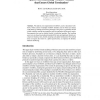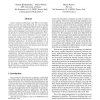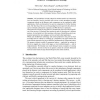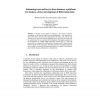BPM
2003
Springer
14 years 3 months ago
2003
Springer
Abstract. We address cross-organizational workflows, such as document workflows, which consist of multiple workflow modules each of which can interact with others by sending and re...
BPM
2006
Springer
14 years 3 months ago
2006
Springer
A framework for modeling Semantic Web Service is proposed. It is based on Description Logic (DL), hence it is endowed with a formal semantics and, in addition, it allows for expres...
EDOC
2004
IEEE
14 years 3 months ago
2004
IEEE
Service-oriented architectures and Web service infrastructure provide the ideal framework for interconnecting organizations and for defining distributed business applications. The...
CBSE
2006
Springer
14 years 3 months ago
2006
Springer
The possibilities currently offered to conduct business at an electronic level are immense. Service providers offer access to their attendances through components placed on the Int...
CAISE
2006
Springer
14 years 3 months ago
2006
Springer
Information system models commonly describe organizations in terms of the structure of the data they use, the organization of the processes they perform and the operations that wil...
CAISE
2006
Springer
14 years 3 months ago
2006
Springer
When modeling business processes, we often implicity think of internal business policies and external regulations. Yet to date, little attention is paid to avoid hard-coding polici...
CAISE
2006
Springer
14 years 3 months ago
2006
Springer
Flexibility of business processes requires a modeling language that can distinguish between the stable and flexible parts of a business process. Starting from a general model of bu...
CAISE
2006
Springer
14 years 3 months ago
2006
Springer
A measure for the quality of software is the extent to which it corresponds to the business objectives and requirements it was designed for. The earlier those who elicit the requir...
CAISE
2006
Springer
14 years 3 months ago
2006
Springer
It is increasingly recognized that business models offer an abstraction that is useful not only in the exploration of new business networks but also for the design and redesign of ...
BPM
2006
Springer
14 years 3 months ago
2006
Springer




